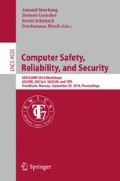Abstract
Autonomous vehicles are predicted to have a large impact on the field of transportation and bring substantial benefits, but they present new challenges when it comes to ensuring safety. Today the standard ISO 26262:2011 treats each defined function, or item, as a complete scope for functional safety; the driver is responsible for anything that falls outside the items. With autonomous driving, it becomes necessary to ensure safety at all times when the vehicle is operating by itself. Therefore, we argue that the hazard analysis should have the wider scope of making sure the vehicle’s functions together fulfill its specifications for autonomous operation. The paper proposes a new iterative work process where the item definition is a product of hazard analysis and risk assessment rather than an input. Generic operational situation and hazard trees are used as a tool to widen the scope of the hazard analysis, and a method to classify hazardous events is used to find dimensioning cases among a potentially long list of candidates. The goal is to avoid dangerous failures for autonomous driving due to the specification of the nominal function being too narrow.
Access this chapter
Tax calculation will be finalised at checkout
Purchases are for personal use only
References
Jang, H.A., Hong, S.-H., Lee, M.K.: A study on situation analysis for ASIL determination. J. Ind. Intell. Inf. 3(2), 152–157 (2015)
VDA: Situationskatalog E-parameter nach ISO 26262-3. VDA 702, Verband der Automobilindustrie e.V. (2015)
Johansson, R.: Efficient identification of safety goals in the automotive E/E domain. In: Proceedings of 8th European Congress of Embedded Real-Time Software and Systems (ERTS2) (2016)
Bergenhem, C., Johansson, R., Söderberg, A., Nilsson, J., Tryggvesson, J., Törngren, M., Ursing, S.: How to reach complete safety requirement refinement for autonomous vehicles. In: Critical Automotive Applications: Robustness and Safety workshop (CARS) (2015)
Kemmann, S.: SAHARA - A structured Approach for Hazard Analysis and Risk Assessments, Technische Universität Kaiserslautern (2015)
Stålhane, T., Myklebust, T., Hanssen, G.: The application of safe scrum to IEC 61508 certifiable software. In: Proceedings of ESREL 2012, Helsinki, Finland (2012)
ISO: International Standard 26262:2011 Road vehicles – Functional safety (2011)
Jesty, P.H., Ward, D.D., Rivett, R.S.: Hazard analysis for programmable automotive systems. In: Proceedings of 2nd International Conference on System Safety, IET (2007)
Vuori, M.: Agile development of safety-critical software. Technical report 14, Tampere University of Technology, Department of Software Systems (2011)
Bainbridge, L.: Ironies of automation. Automatica 19(6), 775–779 (1983). Pergamon Press
National Highway Traffic Safety Administration (NHTSA): Preliminary Statement of Policy Concerning Automated Vehicles. http://www.nhtsa.gov/staticfiles/rulemaking/pdf/Automated_Vehicles_Policy.pdf
Maher, G., Sporer, H., Berlach, R., Armengaud, E., Kreiner, C.: SAHARA: a security-aware hazard and risk analysis method. In: Proceedings of 2015 Design, Automation and Test in Europe Conference and Exhibition (DATE) (2015)
Acknowledgements
The research has been supported by the Swedish government agency for innovation systems (VINNOVA) in the FUSE project (ref 2013-02650).
Author information
Authors and Affiliations
Corresponding author
Editor information
Editors and Affiliations
Rights and permissions
Copyright information
© 2016 Springer International Publishing Switzerland
About this paper
Cite this paper
Warg, F., Gassilewski, M., Tryggvesson, J., Izosimov, V., Werneman, A., Johansson, R. (2016). Defining Autonomous Functions Using Iterative Hazard Analysis and Requirements Refinement. In: Skavhaug, A., Guiochet, J., Schoitsch, E., Bitsch, F. (eds) Computer Safety, Reliability, and Security. SAFECOMP 2016. Lecture Notes in Computer Science(), vol 9923. Springer, Cham. https://doi.org/10.1007/978-3-319-45480-1_23
Download citation
DOI: https://doi.org/10.1007/978-3-319-45480-1_23
Published:
Publisher Name: Springer, Cham
Print ISBN: 978-3-319-45479-5
Online ISBN: 978-3-319-45480-1
eBook Packages: Computer ScienceComputer Science (R0)

